
Soybean, a versatile and nutrient-rich legume, has gained popularity as a valuable stockfeed for livestock due to its high protein content and numerous health benefits. For farmers looking to optimize their livestock’s nutrition and improve overall productivity, incorporating soybean into their feed regimen can be a game-changer. In this comprehensive guide, we’ll explore the various ways to use soybean as stock feeds for different types of livestock.
1. Soybean Meal: A Protein-Rich Feed
One of the most common ways to use soybean for livestock is in the form of soybean meal. After the oil extraction process, the remaining soybean meal contains approximately 44-48% protein. This high protein content makes it an excellent source of essential amino acids, crucial for animal growth, muscle development, and milk production in dairy animals. For farmers, soybean meal can be easily incorporated into animal rations, such as poultry feed, swine feed, and cattle feed.
2. Full-Fat Soybeans for Ruminants
Ruminant animals, such as cattle and sheep, possess the ability to digest whole soybeans effectively due to their unique digestive system. Full-fat soybeans contain both protein and fats, making them a valuable energy source for ruminants. However, it is crucial to process the soybeans properly before feeding them to livestock. Heat treatment or extrusion is recommended to neutralize anti-nutritional factors present in raw soybeans, making them more digestible and safe for consumption.
3. Soybean Hay for Forage
Soybean can also be utilized as forage for livestock, especially in areas where traditional forage sources may be limited. Soybean hay, made from the entire soybean plant (leaves, stems, and pods), provides a nutritious alternative to other types of forages. It is essential to harvest soybean for hay at the right stage of maturity to ensure optimal nutritional content and avoid excessive lignification, which can reduce digestibility.
4. Soybean Silage for Ruminants
Soybean silage is another effective way to utilize soybean as livestock feed, particularly for ruminants. It involves the fermentation of chopped soybean plants, including leaves, stems, and pods, under anaerobic conditions. Proper ensiling techniques ensure preservation of the nutrients, making soybean silage a valuable source of protein and energy during periods when fresh forage is scarce.
5. Supplementing Pasture with Soybean
For farmers who rely on grazing systems, soybean can be used as a supplement to enhance the nutritional value of pasture. By providing soybean meal or processed soybeans as a protein supplement, farmers can improve the overall quality of the diet for their livestock, leading to better growth rates, improved milk production, and overall health.
6. Precautions and Considerations
While soybean is an excellent source of protein and energy for livestock, certain precautions should be taken to ensure its safe and efficient use. Proper processing, such as heat treatment or extrusion, is essential to neutralize anti-nutritional factors present in raw soybeans, which can hinder nutrient absorption and lead to health issues in livestock. Additionally, it is crucial to consult with a livestock nutritionist or veterinarian to determine the right inclusion rate of soybean in the animals’ diet, taking into account their specific nutritional needs, age, and production stage.
7. Storage and Quality Management
To maintain the nutritional value of soybean stock feeds, proper storage and quality management are paramount. Keep soybean meal and processed soybeans in cool, dry conditions to prevent mold growth and nutrient degradation. Implementing a first-in, first-out system for feed storage ensures that the oldest stock feeds are used first, minimizing the risk of spoilage.
In conclusion, soybean is a valuable and versatile stockfeed option for livestock farmers. Its high protein content and numerous health benefits make it an excellent addition to animal rations, improving growth rates, milk production, and overall animal health. By utilizing soybean meal, full-fat soybeans, soybean hay, silage, or as a pasture supplement, farmers can optimize their livestock’s nutrition and boost productivity. Implementing proper processing and storage techniques is crucial to ensure the safe and effective use of soybean stock feeds. By incorporating soybean into their livestock management practices, farmers can unlock the full potential of their livestock and reap the rewards of healthier and more productive animals
Stay updated with the latest farming tips and agriculture industry news from Africa by subscribing to our newsletter. Don’t miss out on valuable insights and updates. Follow us on Twitter, LinkedIn, and Facebook to join our farming community and stay connected with us.



















